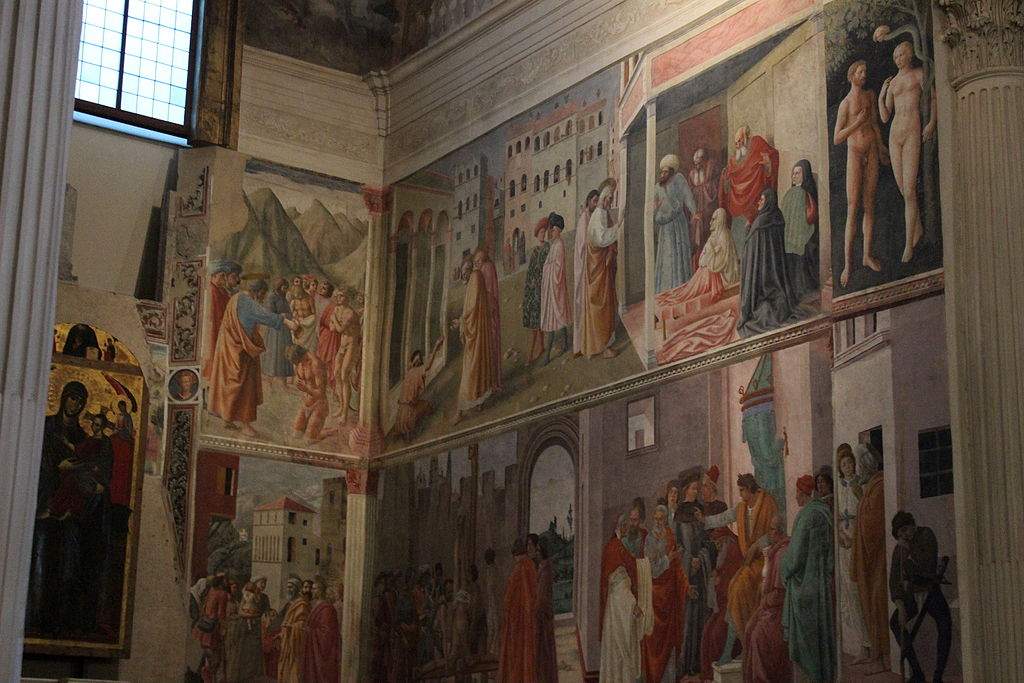The restoration of the Brancacci Chapel in Florence, announced a year ago, has begun. The Chapel, home to key frescoes by Masaccio and Masolino da Panicale, among the starting points of the Renaissance, as well as those by Filippino Lippi, who finished the work left unfinished by his two predecessors, is located inside the Church of the Carmine and is part of the Florentine civic museums. It will be restored, but it will not close: from February, in fact, the public, as had been announced in recent months, will be able to climb the scaffolding necessary for the work in order to admire the masterpieces by Masaccio, Masolino da Panicale and Filippino Lippi for the first time at close range. A unique opportunity, then, to get an up-close look at the protagonists of the frescoes, such as Adam and Eve tempted by the serpent and then banished from Paradise.
The restoration of the Chapel will last one year, and the work is part of a comprehensive research and enhancement program put together by the City, Soprintendenza, CNR-Ispc of Florence, Opificio di Pietra Dure and the U.S.-based Friends of Florence Foundation, in co-partnership with the Jay Pritzker Foundation. The Chapel was closed to the public in December to allow scaffolding to be erected, and will reopen in February, on Fridays, Saturdays and Mondays from 10 a.m. to 5 p.m., and Sundays from 1 to 5 p.m., with reservations required online or through a call center (according to the procedures that will be indicated on the website cultura.comune.fi.it).
The last restoration of the Brancacci Chapel dates back to the 1980s. In November 2020 the Chapel underwent an initial monitoring that had revealed some critical issues from the point of view of conservation and the need to stabilize some potential deterioration phenomena present on the pictorial cycle of Masolino, Masaccio and Filippino Lippi (plaster detachments, localized loss of cohesion, inconsistent surface deposits) as well as perform a general check on the stability of the entire pictorial cycle whose last restoration dates back more than thirty years.
January saw the start of monitoring on the state of health of the Brancacci Chapel by SABAP Florence (Soprintendenza Archeologia, Belle Arti e Paesaggio for the Metropolitan City of Florence and the Provinces of Pistoia and Prato) and CNR (Consiglio Nazionale delle Ricerche) in collaboration with the Opificio delle Pietre Dure in Florence. Thanks to the current site, it is now possible to carry out a new diagnostic campaign, more in-depth and comprehensive than the previous one, with the most up-to-date techniques and the best expertise available on the international scene thanks to the collaboration between SABAP, CNR and OPD. The techniques used, which are completely non-destructive, will provide in-depth knowledge of the materials used, painting techniques and alteration/degradation phenomenologies, information that is indispensable for proper planning of the restoration work.
At present, photographic imaging investigations are underway in the various bands of the electromagnetic spectrum, from visible to infrared, in high definition and grazing light, aimed at identifying areas with anomalies otherwise imperceptible to visual inspection. The immediately following activities are aimed at increasing the level of cognitive detail on the details identified in the previous diagnostic phase. The process of cognitive deepening will follow an iterative pattern until everything is clearly interpreted. The resulting record of the state of health of the frescoes and the masonry apparatus of the chapel that houses them will be the basis for the checks in subsequent years.
“Being able to almost touch the frescoes usually seen only from the bottom up is really exciting,” says Mayor and Councilor for Culture Dario Nardella, “and in the coming months visitors and tourists will be able to take advantage of this truly unique opportunity. The alternative, which was to close the Brancacci Chapel for the entire time of the restoration, seemed to us to be a really big detriment, especially after the prolonged lockdown period for our museums because of Covid. We are grateful to the City’s fine arts, restorers and technicians for allowing this possibility of access, and we are especially happy, moreover, to have the Friends of Florence Foundation on our side again, which really shows itself to be a ’friend’ of the city by having its artistic heritage so close to its heart.”
“Friends of Florence,” says president Simonetta Brandolini d’Adda, “is supporting the intervention on the frescoes of the Brancacci Chapel through the gift of some of the supporters closest to our foundation: Dan Pritzker of the Jay Pritzker Foundation, a member of the board of Friends of Florence; Janet and Jim Dicke II, also a member of the board, with his wife a supporter of our foundation’s projects for 23 years; and Peter Fogliano and Hal Lester Foundation donors to Friends of Florence for more than 15 years. We are very grateful to all of them for their closeness and support of our projects and we are happy to begin this intervention, aware of the importance that the Brancacci Chapel has for Florentine, Italian and international culture. Our thanks also go to the Municipality of Florence, the Soprintendenza Archeologia Belle Arti e Paesaggio for the Metropolitan City of Florence and the Provinces of Pistoia and Prato, the CNR and the Opificio delle Pietre Dure, entities with which we have been collaborating for years, whose synergy will be fundamental for the development of the entire project.”
Pictured: the Brancacci Chapel. Photo by Miguel Hermoso Cuesta
 |
| Florence, Brancacci Chapel restoration begins. You will be able to see the frescoes on scaffolding |
Warning: the translation into English of the original Italian article was created using automatic tools. We undertake to review all articles, but we do not guarantee the total absence of inaccuracies in the translation due to the program. You can find the original by clicking on the ITA button. If you find any mistake,please contact us.